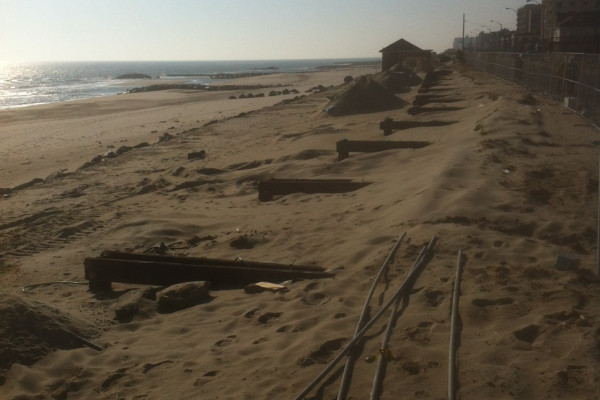Terri Bennett’s students at Pratt Institute in Fort Greene, Brooklyn, bring a lot of digital tools to class. But the 37-year old English instructor said she likes the feel of an old-fashioned notebook.
“I do believe that there’s something to be said for writing something down, thinking about it, and then transferring it onto some kind of digitized mechanism,” she told me during a lunch break at a café near the school. “I think it actually makes things...maybe a little bit more meaningful and deliberate.”
Along with her partner, Bennett founded Respond and Rebuild, an organization that helped Rockaway residents clean, eliminate mold in, and reconstruct their homes after the hurricane. With four other members and, according to its website, almost 2,000 volunteers, the organization worked in over 430 homes.
Bennett had experience responding to a disaster overseas. As an undergraduate, she became interested in international development and traveled to Thailand, where she observed a lack of communication between non-native researchers and the rural residents whose lives they sought to improve. That’s when Bennett realized that “how we conceive of development and aid might be a little problematic,” she said.
She was studying humanitarian aid and disaster relief at The City University of New York’s Graduate Center when the 7.0 magnitude earthquake struck Haiti in January 2010. She found herself empathizing with the Haitian population in her borough.
“I remember just thinking [about] what the community in Brooklyn must have felt, just not being able to know what was happening with their loved ones,” she said.
She took a break from academia and went to Haiti for five months, where she helped reconstruct schools, taught language and computer classes to young people, and aided the response to cholera, she said. Back home, her experiences moved her to form Respond and Rebuild, to organize and advise volunteers in Rockaway after Sandy.
Early on, Bennett began using Facebook in ways similar to other volunteers. She and her partner posted photographs of the destruction on the peninsula, some of which included them in the frame. Old friends offered to send money, which they used to purchase tools, safety equipment, and gas; they posted pictures of themselves at work, and thanked the donors.
Reflecting at the café, Bennett said that social media users after Sandy helped volunteers and large organizations gather lots of information quickly, which she called “the most teachable moment” of the relief and recovery effort.
She also described another lesson: social media conveyed a different picture of relief than commercial media. In Haiti and Rockaway, Bennett said, the first responders were members of local communities, not large aid organizations, but it took Facebook pages like Rockaway Emergency Plan to show that.
“When you’re relying on large news corporations, you get a similar story from disaster to disaster about victimhood,” she said. “[It’s] definitely not what we were seeing after Sandy.”
She thinks that widespread representations of grass-roots efforts will empower “people affected by” disasters—Bennett prefers this syntactic construction—to take more charge of their recovery.
“When the organized disaster relief industry does mobilize and enter the situation, there’s an important distinction between seeing them as one source of help and being saviors,” she said. “That’s a really different story.”
Bennett also talked about one essential part of disaster relief that Facebook couldn’t do: knock on doors and speak with people offline. She recalled helping a couple that lived in a damaged home near Respond and Rebuild’s office at Arverne Pilgrim Church. The husband couldn’t walk, and his wife could not converse in English.
“We were able to have someone that spoke Spanish go to their house, see what they needed, [and] see if we could match them up with services that were available in the community,” she said.
“In our case, I don’t know that social media was the most effective way of finding the people who were most vulnerable.”
Nor was it how Bennett and her partner met a skeptical couple with a flooded basement on Rockaway Beach Boulevard, the second space the volunteers pumped out after the storm.
“We were wearing clothes covered with mud, my partner has a lot of tattoos, we didn’t look to them like people they would normally be talking to,” she said, about to go back to work at Pratt. “Within a couple of weeks, she’d given us the keys to her house so we could check on the boiler, check to make sure the pumping had worked, things like that,” she said.
“These kind of unexpected friendships [were] just something really amazing to come out of something that was so terrible.”
In one way or another, that’s what everyone said.

